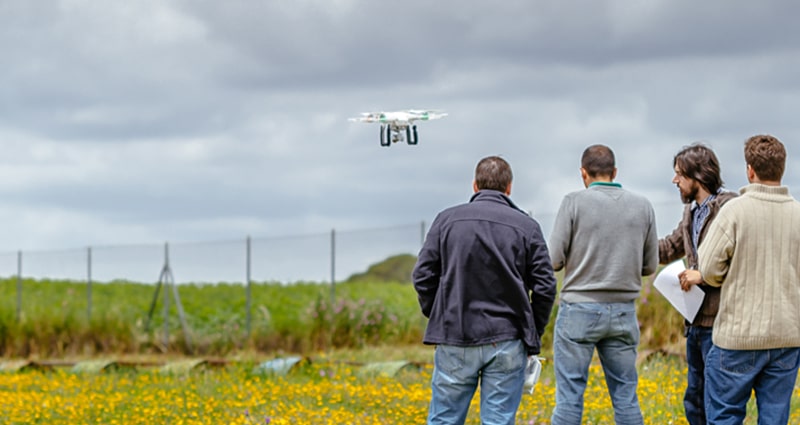Developing a Safety Culture Through an Internal Pilot Qualification Program

As the small unmanned aircraft system (sUAS) industry continues to grow rapidly, large organizations are latching on to this industry‐altering technology and creating various models to scale and implement unmanned aerial vehicles (UAVs) in their everyday operations.
However, many organizations are discovering that there are numerous roadblocks, two of the biggest being safety and the decision on when an sUAS pilot is prepared to launch an aircraft. In response, they are developing internal pilot qualification programs.
With risk and overall safety being a top concern for many organizations, creating an internal pilot qualification program that is scalable and meets the safety and operational needs of that specific organization is crucial for successful sUAS flights and knowledgeable pilots.
Through DARTdrones’ experience with many of the leading organizations in broadcast media, industrial inspections, and public safety, we will broadly cover the steps to successfully creating an internal program, curriculum trends that are seen to be effective in various commercial industries, common roadblocks, and more.
GUIDE FOR BUILDING AN INTERNAL PILOT QUALIFICATION PROGRAM
Part 107
An internal pilot qualification program needs to go beyond a Part 107 Remote Pilot Certificate. Launching commercial sUAS flights can put many legal and safety concerns onto an organization. And although Part 107 covers airspace, weather restrictions, etc., it becomes the organization’s responsibility to be sure the operator’s knowledge exceeds the basics.
The overall success of any sUAS flight depends on the ability of the pilot to properly configure and operate the aircraft with an expert level of proficiency. This is something that comes after establishing the Part 107 rules and regulations. Adding training beyond Part 107 into your program is essential before conducting commercial operations.
Mission-Specific Training
Once a Part 107 Certificate is obtained, it is important to determine the types of sUAS flights your organization’s pilots will be launching. Will they be flying at many different work sites? Will they have to fly/manage multiple sUAS models? Determine what knowledge your pilots will require to actually fly a safe mission, and build your curriculum and qualification program around those factors. For example, if night operations are a large portion of your pilot’s flight time, then a night operations-specific training component is critical.
DARTdrones has seen organizations focus their programs around topics such as airspace, site and weather assessments, equipment care, flight safety, night operations, and how to utilize a visual observer (VO).
Operational Considerations
Next, your organization should determine how this program will actually work, exactly how pilots will flow through the program, and how the program will fit into other aspects of the organization. A few factors to consider are when will they begin the program (eg., as soon as a Part 107 Certificate is obtained), will the program consist of online learning modules or in-person training, will there be a test after each section, what score will pilots need to achieve to pass the complete program, and will there be any hands‐on flight assessments?
Common Roadblocks
Many organizations have trouble building a clear path for their pilots to follow. There are many factors that go into professional flights, such as quick and precise decision making and understanding system capabilities, but knowing which of these factors matter most for the safety and legal concerns of the organization is a major point of difficulty. For help developing a customized internal qualification program, contact DARTdrones.
HOW AN INTERNAL PROGRAM WILL IMPACT AN ORGANIZATION
Developing an internal pilot qualification program will mitigate risk and increase the overall safety culture of your organization. Within the sUAS industry, it is known that 75 percent of accidents can be attributed directly to operator error. Building a qualification program around the unique sUAS missions your organization will be launching will decrease operator error, increase mission predictability, and prepare pilots through real‐world, scenario‐based training.

DARTdrones, the nation’s leading drone training company and Global Aerospace SM4 partner, offers courses in 40+ cities across the U.S. DARTdrones offers basic flight training classes, Part 107 Airman Knowledge test prep courses, advanced industry specific training, and UAS program implementation consulting services. DARTdrones has been helping individuals and organizations develop safe and efficient sUAS programs and continues to keep new and developing safety considerations at the forefront of their curriculum development. For more information, visit us or call the team at 800-264-3907. DARTdrones was featured on ABC’s Shark Tank in February 2017.
http://www.dartdrones.com
© 2025 DARTdrones. All Rights Reserved.
Next ArticleRelated Posts

Part 108: The Next Step in BVLOS Integration and Drone Innovation
As the drone industry awaits the Federal Aviation Administration’s (FAA) forthcoming Part 108 regulations, the landscape of Beyond Visual Line of Sight (BVLOS) operations stands on the brink of transformation. These anticipated rules aim to standardize BVLOS flights, enabling more complex and expansive drone missions across various sectors.

Giving the Hazard Log the Attention It Deserves
Safety risk profile. Hazard log. Hazard risk register. Whatever you call it internally, one thing is clear: It is a fundamental requirement in your safety management system.

